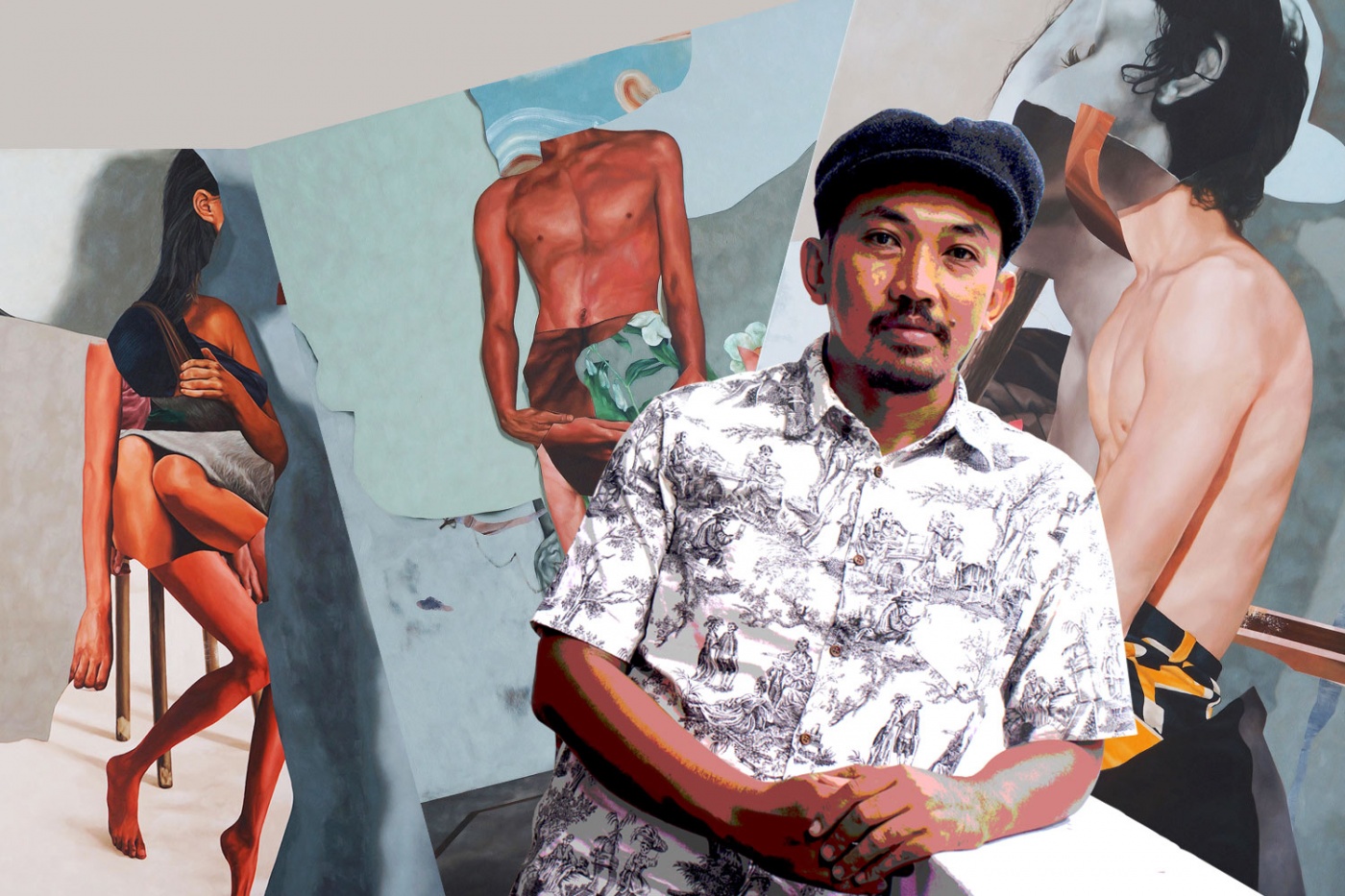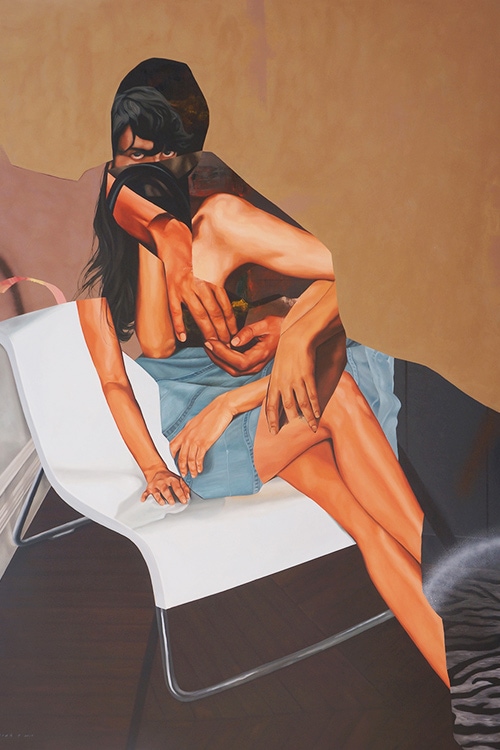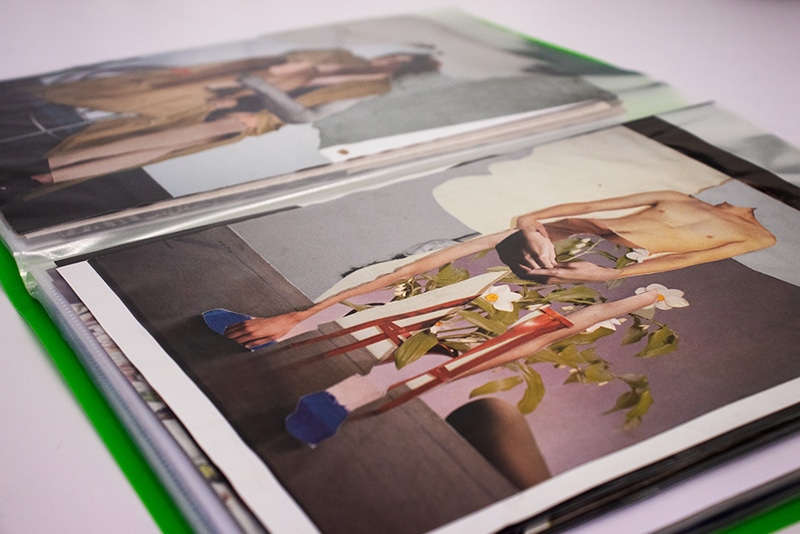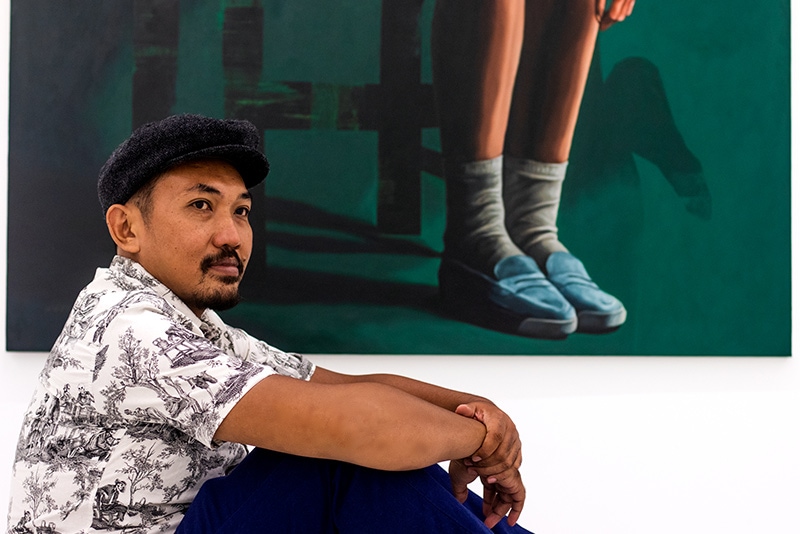Wedhar Riyadi: Art is a Universal Language
What Makes Art, Art is a series that delves into some of art’s biggest questions and picks the minds of various individuals from the art industry to uncover diverse perspectives that stimulate, inspire, confront and even clash
At Yavuz Gallery, nine oil paintings tower over me, each depicting a surrealist collage of exposed bodies, forcing me to confront these fleshy images. They’re a little grotesque, yet undeniably beautiful. Intimate, yet oddly detached. These are the works of Jogjakarta-based artist Wedhar Riyadi, who is in town for his first solo exhibition in five years. It’s entitled Slices—a word that conjures the pain and agony of torn skin, while nodding to the fragmentation and objectification of the human body.
Previously employing a more graphic style to his art, Wedhar now devotes himself to a much more traditional and elevated medium—oil on canvas—while putting a contemporary twist to it. His process begins with collecting old magazines from flea markets, which he uses to create collages, ripping and slashing apart these picture-perfect bodies to form distorted images. The next step is to reproduce these collages onto the canvas, a skill that Wedhar admits he’s still trying to master.
“Painting is actually very hard for me… I have to think a lot about the composition, texture, colour, the idea, and the content. I find facing a blank canvas very terrifying, but I keep doing it because I hope that one day I’ll overcome this fear and become comfortable with the medium,” says the meek artist. Indeed, there’s beauty in suffering.
I can tell in his awkward, apologetic manner and his occasional stutter that even this interview is a challenge for him to get through, considering the language barrier and our need for an interpreter to communicate. Perhaps this is part of why he makes art. Through his paintings, Wedhar could be ten times more eloquent than when he speaks in his native tongue, conveying his deepest emotions and the most complex of ideas.
“Art is, for me, like a language that allows me to speak to all kinds of people around the world,” he shares. A few strokes on the canvas could evoke a diversity of juxtaposing sentiments, and tell a richer story than any New York Times bestselling novel—exactly what Wedhar does with his depiction of the human skin.
High Net Worth: What sort of ideas and themes are you currently obsessed with?
Wedhar Riyadi: Society is obsessed with the media and information but you only get one side of the picture—and a lot of information is hidden. With technology and social media, a lot of things are lost or forgotten. Even though technology is supposed to help us, it actually hinders us in many ways. For instance, a lot of things now happen across social media. We don’t really meet face-to-face. There’s that lack of contact. That’s something that I’m currently obsessed with and am looking into.
Does that affect the way you make your art?
Yeah. I wanted to bring back the humanity of it all. That’s why I do these collages, where the main focus is the human body. Hence, the idea of going back to the body. You can read so much into the human skin. You can see softness, violence, desire. I take a lot of these images from magazines and print advertisements, and I see that there’s a lot of cosmetics involved. There’s this superficial, plastic quality. I cut these images up and put them together to highlight that quality even further. I’m also trying to overturn this image seen in magazines. I rearrange the cut-up pieces of these images of the human body to highlight aspects of our humanness and the tension between our humanity and the way it’s portrayed in the media.
What fascinates you most about the human body?
I’m very fascinated by the human body because it can tell you a lot of stories just by looking at a person’s skin and body. There’s so much variety as well. You can notice a cut, a scar, or how rough the skin is. All of that reveals something about the person, or about humanity. There’s also the skin tone, the skin colour… There’s so much detail in the human body. If you just look, I think you can see quite a lot. What gets represented most in magazines is usually beautiful skin, skin that’s very smooth. You don’t get other kinds of skin or bodies that may not seem very beautiful, but actually have a lot to tell.
I’ve noticed that a lot of interaction between people are very far away from reality. It’s part of the effects of social media, in the sense that we don’t know who we’re talking to or who we’re interacting with. Face-to-face interactions and contact are a very important aspect of what it means to be human, but it’s no longer done as much. People just text and connect with each other digitally now, which is quite impersonal.
What kind of emotions are you trying to evoke with your paintings? What do you want viewers to feel?
Viewers should feel a lot of things when they see my work. The hurt, the fear, the softness, the roughness, the wounds of the person… Collages are also made by cutting images up with a knife. There’s a kind of violence in the very act of creating these artworks. That’s the sensation that I’m trying to get across.
Why do you choose not to present collages as the end product? Why reproduce them as oil paintings?
It’s important for me to make a bigger painting out of a collage because I want to expose the details and the feel of the skin. Through painting, especially on a canvas with much larger dimensions, I can manipulate the texture and colour of the skin to tell a richer, more complex story. This relates back to the idea of how the skin and bodies that you see in the media is perfect. What I’m trying to do is highlight the imperfections and the different types of skin.
Do you read a lot of magazines, or did you collect them just for this project?
Just for this project.
What kind of magazines do you use?
I usually get second-hand magazines at the flea market. Usually fashion magazines, fashion advertisements, images that are more air-brushed and perfected. It’s very interesting to play with the composition of the body. I also tend to cut out the parts of a picture with exposed skin.
How do you decide where to place each part in a collage?
I use my instinct and intuition.
Do you have to feel inspired before you create an artwork, or do you just dive in?
I just do it. I’ll start with matching pieces of cut-out images. I’m also constantly working. I’ll do drawings, collages and studies. Through this process of continuing to work, that’s where inspiration might come in. I don’t have a fixed schedule. I have a child. Every day, I take my kid to school and sometimes I’ll be busy. In between my errands, I might do some work and make some art.
How do you know when an artwork is complete?
It’s based on how I feel. In the process of turning a collage into a painting, I may add another colour, or change the texture. It happens organically. That’s also why I transfer it onto the canvas. I’m able to use my human instinct to add more layers to the image.
What do you think it means to be human?
It’s very interesting to be a human being. A lot can be explored in humanity. There’s a lot of richness in humanity. Because we’re not robots, we’re not systematic. Being human is to be able to change and be flexible.
As an artist, what do you do to improve yourself?
I try to pick up different subject matters and styles. I design album covers and books as well. Before, my style used to be comical, a combination of comics and paintings. Right now, I’m still learning… It’s still a new world to me, this world of making collages and oil paintings.
How long do you take to finish a piece of art?
Around a week when I’m working on the canvas, after the collage has been finished.
What kind of art do you personally enjoy?
I like drawings because they’re very personal. It’s also very easy and basic. You can draw anywhere and at any time. Painting is actually very hard for me. It’s terrifying. I have to think a lot about the composition, texture, colour, the idea, and the content. I find facing a blank canvas very terrifying, but I keep doing it because I hope that one day I’ll overcome this fear and become comfortable with the medium. Maybe once I’m comfortable with it, I’ll try something new again.
Do you personally collect artworks?
No, because I don’t have a lot of money. [laughs] I collect drawings sometimes, or exchange artworks with my friends.
What do you think makes good art?
Art is something that should make the audience feel something. It can be beautiful, but I think it has to have something more to say. It shouldn’t just be a beautiful object. Art is, for me, like a language that allows me to speak to all kinds of people around the world. It’s a way to present my opinions and ideas. I’m not very expressive or aggressive in person, and you can see that in my paintings. I’m very careful with my strokes. They’re not wild or aggressive at all.
[Read More: Emi Eu: Everything in Life is Art]
[Read More: Shubigi Rao is Not Your Typical Artist: “I Don’t Make ‘Art’ Art”]
[Read More: Tom Tandio: A Journey of Self-Discovery Through Art]





